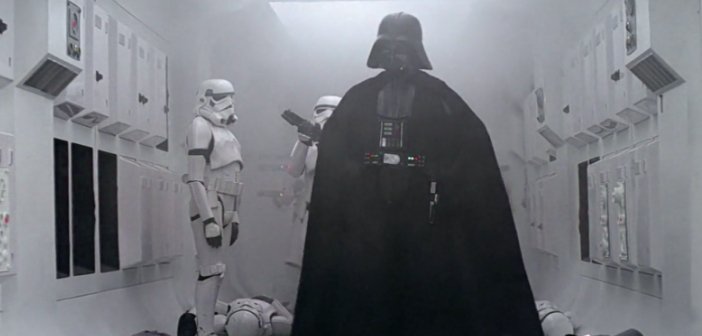An Objective Analysis of Star Wars: A New Hope… 40 Years On
Star Wars is unquestionably a film lessened by everything that has come after it. For one, we can’t even simply refer to it as Star Wars; it has to be labelled Episode IV: A New Hope. This is to say nothing of how every frame, every shot and every line has been mythologised, poured over and given at least two novels and a six-part comic book miniseries expanding on it. As the film reaches another birthday and it comes time to look at it once again, it would be difficult for any self-respecting Star Wars fan to evaluate it without bringing all the nostalgia and associated clutter the film has accumulated over the decades. Which is why the challenge has fallen to me; the guy-who-never-loved-Star-Wars-and-didn’t-really-engage-with-it-as-a-child-and-thinks-it’s-generally-fine, for as close to an objective appraisal of the film as a film you could reasonably expect.
[arve url=”https://www.youtube.com/watch?v=1g3_CFmnU7k”]
One of the few unassailable facts of the film is how good the score is. While we could get into a nuanced debate about whether this or the score for Superman is the more accomplished score of John Williams’ career – at a push I might say Supes – the importance of the score here is not up for debate. In fact, the score utterly carries the film in places. Most of all during the nigh unwatchable opening section of the film where we’re stuck with nothing but sand, droids and Jawas faffing about the place for what feels like an eternity. The ever-inventive and fun music is damn near the only thing to keep you on board. Imagine being an audience member in the 70s and sitting through that; wholly unclear as to what was going on or who the main character was because lest we forget, he hasn’t even entered the film yet. And on that note…
It’s an oddly structured film when you think about it. It’s wall-to-wall action for the second half with barely a breath between the rescue of Leia/daring escape from the Death Star and the big climactic battle yet the for the first hour the pace is positively glacial. Then of course there’s the strangeness of having the film open on a very strong and tense ship-boarding, filled with iconic introductions to important characters, only for us to be stuck with two of the least watchable characters in the franchise for a quarter of an hour as they get kidnapped. To its credit, this all contributes to the kind of world-building that the likes of John Wick get correctly praised for; little in the way of exposition, simply a demonstration of how characters operate within this universe and trust your audience to go with it. This is more of an observation than an outright criticism but it’s bemusing to think just how thoroughly a modern blockbuster would never dare attempt it.
Once we do finally reach Luke, and more importantly Kenobi, the film remains the eminently watchable ‘old fashioned adventure in space’ it was always conceived as and much of this is down to cast. By and large, they all hold up; Fisher and Cushing probably being the standouts along with Guinness, and while Hamill’s youth shows, the promise of the stronger actor he’d become is clear. Ford is far more enjoyable in the role than he has any right to be given the insufferable archetype pop-culture has turned Solo into. Anthony Daniels’ C3PO was and always will be knuckle-whiteningly irritating but people seem to find that character endearing so here we are. If there’s a curious weak-link that slightly stands out, it’s Vader. The disconnect between Prowse in the suit and Jones as the voice had not yet been bridged while additionally, they couldn’t have known the sheer magnitude of the icon they were creating and as such Vader seems a lot more hysterical in this initial appearance. The calm, collected and deliberately slow mannerisms that now typify the character – both physically and especially vocally – are absent here as he’s happy to scream loudly and gesticulate with more wild abandon than we’ve ever seen since while Jones barrels through lines in a manner that feels distinctly casual rather than imposing.

It would obviously be ridiculous to ask a Star Wars fan if the original film holds up but to those who’ve never seen it, are ambivalent or who simply don’t care, it remains a quite enjoyable film on the whole. The lack of an immediate audience surrogate character lets the world-building unfold organically and achieve that much sought-after lived-in/used universe feel that so many blockbusters strive for. We’ve already discussed the staying power, narrative importance and general hum-ability of the score but even on a visual and sound design level, the film is a masterclass. Ultimately, it’s a film somewhat ruined by the crippling weight of everything it spawned. The universe is so vast and variety of media available so broad and specialised that it’s hard to imagine that anyone coming to this film now having been raised on, say, the video games or the various animated properties would find enough of whatever their preferred aspect of the universe is, to be satisfied. But if you can detach yourself from all that and look at it as it was intended (as a sister film to Indiana Jones of sorts); a well-made, big-budget recreation of the serials of yesteryear, then there remains an enjoyable, well-executed romp here… that just so happens to be the progenitor to one of the biggest entertainment properties known to man.
Oh, and if you watch it on anything with a picture quality higher than VHS, have fun being unable to notice Cushing’s single errant strand of hair, bouncing majestically in the light in practically every shot he’s in.
Featured Image Credit

